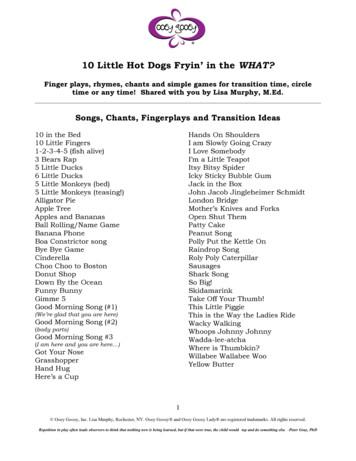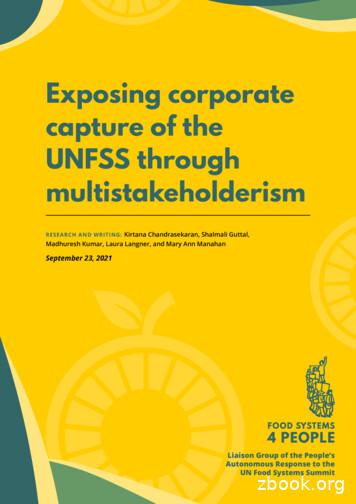What Range Herbivores Eat— And Why
B-6037What RangeHerbivores Eat—and WhyTexas Agricultural Extension Service Zerle L. Carpenter, Director The Texas A&M University System College Station, Texas
What Range Herbivores Eat—and WhyRobert K. Lyons, T.D.A. Forbes, and Rick Machen*Different range animals have different diets—some eat grass, some eat browse (leaves fromwoody plants) and forbs (wildflowers, weeds,etc.), and some eat all three. The differences intheir diets allow many types of range animals tocoexist on the same range.For many years, the major herbivores onTexas ranges were cattle, sheep, goats, deer, andhorses. Recently, however, several new herbivore species (such as axis and fallow deer) havebeen introduced to Texas from Asia and Africa,and there is some isolated interest in reintroducing the American bison. With the introductionof new species and possible reintroduction ofnative species, it is important to understand thediets of different animals to determine whichones best fit different range habitats.Although a herbivore is, by definition, a planteating animal, herbivores do not eat just anyplant. For example, if a deer, which is adaptedto eat forbs and browse, is forced to eat largeamounts of grass, it will probably not performas well as deer that eat forbs and browse.The type of diet selected by range herbivoresis determined by their mouth parts and theanatomy of their digestive systems. A soundunderstanding of what range herbivores eat andwhy will allow the landowner to use the rangeland resource more wisely and enable the animals to perform better.What Range Herbivores EatThe diets of range herbivores vary among different species (Figure 1, page 2) and within thesame species by season of the year (Figures 2and 3, pages 4 and 5).On an annual basis, bison eat mostly grass, afew forbs, and little browse (Figure 1). Cattle eatless grass, but more forbs and browse thanbison. Horses are similar to bison and cattle inthat they eat mostly grass and only smallamounts of forbs and browse. Sheep eat lessgrass than either bison or cattle, slightly moreforbs than cattle, and more than three times asmuch browse as cattle.*Assistant Professor and Extension Range Specialist; AssociateProfessor, Grazing Ecology; Assistant Professor and ExtensionLivestock Specialist, The Texas A&M University System.Goats eat about equal amounts of grass andbrowse and about the same amount of forbs ascattle. Because Spanish goats are more efficientbrowsers than Angora goats, they can maintainmore browse in their diets than Angoras whenbrowse is scarce. Spanish goats are more efficient browsers because they are taller and can browse at greaterheights. they have less hair to get caught in denserbrush.Of the Texas range herbivores, deer—bothwhite-tailed and mule—eat the most browse.Although mule deer appear to eat more browseand less forbs than white-tailed deer (Figures 1& 3), these differences are probably due to thekinds of forage available. Diets often reflectavailability of forage types: for example, deerprefer forbs, but browse is probably a morereadily available food source during tough times.Diets also vary from season to season. Forexample, cattle eat more grass in winter and lessin spring; more forbs in spring and less in falland winter; and more browse in fall and less inspring (Figure 2). In comparison, white-taileddeer consume more or less the same amount ofgrass across all seasons; more forbs in springand less in winter; and more browse in winterand less in spring (Figure 3). The diets of someanimals, like bison, are relatively stable acrossseasons (Figure 3).Differences in the types of forages consumedby range herbivores are due to both internal(digestive system) and external (such as mouthsize) physical differences among these animals.These physical differences have been used toclassify herbivores into different feeding types.Herbivore Feeding TypesAnimal digestive systems lack the enzymesrequired to break down or digest the chemicalbonds found in the cell walls of plant material(cellulose). Animals that use cellulose can do sobecause they have microorganisms in theirdigestive systems that have the chemicals needed to digest it. Cellulose is digested by fermentation. Fermentation requires time and a conducive environment in the digestive system
CattleSheepBrowse (7)GoatsBrowse (22)Browse (43)Forbs (12)Grass (45)Forbs (17)Grass (61)Grass (81)BisonForbs (5)Forbs (12)White-tailed DeerBrowse (2)Browse (52)Grass (12)Mule DeerGrass (10)Browse (72)Forbs (18)Forbs (36)Grass (93)HorsesForbs (6)Pronghorn AntelopeBrowse (4)Browse (50)Grass (18)ElkBrowse (20)Forbs (16)Grass (64)Grass (90)Forbs (32)Figure 1. Average annual diet composition by percent grass, forbs (wildflowers, weeds, etc.) and browse (leaves of woodyplants) for cattle (Edwards Plateau and South Texas), sheep (Edwards Plateau), goats (Edwards Plateau), bison (Colorado),white-tailed deer (Edwards Plateau and South Texas), mule deer (western United States), horses (western United States),pronghorn antelope (western United States), and elk (western United States) on rangeland (adapted from Vallentine 1990).2
where food can be held long enough for themicroorganisms to break down the cellulose.MonogastricsAnimals with one simple stomach, like horsesand swine, are called “monogastrics.” Mostmonogastrics do not use cellulose because theydo not have a specialized part of the digestivesystem where fermentation can take place. Somemonogastrics (like horses, rabbits) have either anenlarged stomach or areas in the large intestineand/or cecum where fermentation can takeplace. Monogastrics with an enlargedstomach (like the hippopotamus) arecalled “foregut fermentors”because fermentation occurs inthe front part of the digestivesystem. Monogastrics in whichfermentation occurs in the rearpart of the digestive system arecalled “hindgut fermentors”(like the horse, zebra, andrhinoceros).RuminantsRuminants are different from monogastricsbecause they have fourcompartments in thefront part of theirdigestive systemsand because theychew their cud.One of these compartments, the abomasum, is the same as themonogastric stomach.The rumen creates aphysical restriction tothe passage of foodthrough the digestivesystem. For food toleave the rumen, thefood particles must besmall and heavy, whichrequires rechewing and fermentation time in the rumen. About 155 ruminant species now exist in the world. Mostlarge herbivores on Texas rangelands are ruminants (cattle, sheep, goats, and deer). Althoughcamels and llamas chew their cud, they are nottrue ruminants because they lack one of thefour compartments of a ruminant stomach.Feeding Type and Forage AvailabilityDepending on the quality and quantity ofthe forage available, there are advantages anddisadvantages to being a ruminant or hindgutfermentor.If forage quality is low but forage quantity isabundant, hindgut fermentors have the advantage because there are no physical restrictions tofood passage in their digestive systems—thisallows food to move through the digestive system quickly. Consequently, animals with thiskind of digestive system can meet their nutrientneeds by eating large quantities of low-qualityforage. In the same situation, a ruminant animalwould be at a disadvantage because low-qualityforage takes longer to break down, and thephysical restrictions to food passage in theirdigestive systems limit the amount of foragethey can eat.Therefore, aruminant animalwould not beable to get enoughlow-quality foragethrough its digestivesystem to meet itsnutrient needs.If forage quantity islimited and forage quality is moderate, a ruminant would have theadvantage because thephysical restrictions tofood passage hold foragein the digestive tract longer,allowing it to be digestedmore completely.Both hindgut fermentors and ruminants could be ata disadvantage ifboth foragequantity andquality are low.Hindgut fermentors are a
four compartments of a ruminant stomach. Feeding Type and Forage Availability Depending on the quality and quantity of the forage available, there are advantages and disadvantages to being a ruminant or hindgut fermentor. If forage quality is low but forage quantity is abundant, hindgut fermentors have the advan-
(C) a grassland food chain (D) an undersea food chain 3 How are herbivores and omnivores different? (A) Herbivores eat only plants, while omnivores eat plants and other animals. (B) Omnivores eat only animals and herbivores eat only plants. (C) Herbivores are found only in land food chains while omnivores are found only in ocean food chains.
Scalarexponential: Matrixexponential: eat 1 at a2t2 2! a3t3 3! . eAt I At A2t2 2! A3t3 3! . ea 0 1 eA I e at 1 eat e At eAt 1 ea (t1 2) eat1eat2 eA 1 t2) eAt1eAt2 e(a1 2)t e1tea2t e(A1 A2 eA1te 2t onlyifA 1A2 A2A1 d dt e at ae eata d dt eAt AeAt eAtA t 0 eatdt 1 a eat 1 t 0 eAtdt A 1 eAt I eAt I A 1 ifA
spaige@eat.uk.com mmota@eat.uk.com vwood@eat.uk.com flewis@eat.uk.com 01924 478 482 Reach Academy Head Teacher Hannah Lord hlord@eat.uk.com 01924 478 482 Ethos College DSL Diane Dunn ddunn@eat.uk.com 01924469170 07803508293 Ethos College DDSLs Lucy Beeby Michelle Brown lbeeby@eat.uk.com mbrown@eat.uk.com 07803508245 07803508232
Omnivores Herbivores B 6. Consumers that eat only plants Producers Herbivores Omnivores A 7. For energy, eat both plants and animals Omnivores Producers A 8. All of the populations of different species that live in an ecosystem Community Ecosystem Population C 9. The process which energy from the Sun is converted into carbohydrates,
Eat, Pray, Love Eat, Pray, Love Eat, Pray, Love Eat, Pray, Love ALSO BY ELIZABETH GILBERT Pilgrims Stern Men The Last American Man Eat, Pray, Love Eat, Pray, Love VIKING Published by the Penguin Group Penguin Group (USA) Inc., 375 Hudson Street, New York, New York 10014
Apple Tree Way up high in the apple tree I saw two apples smiling at me I shook that tree as hard as I could Down came the apples Mmmmm they were good Apples and Bananas I like to eat, eat, eat Apples and bananas I like to eat, eat, eat Apples and bananas Then sing it substituting various first sounds to the sound of each vowel:
EAT EAT consists of the EAT Forum, EAT Foundation, and the EAT-Lancet Commission on Sustainable Healthy Food Systems. EAT . Bayer, City Finansiering, Deloitte, Google, Novo Nordisk, Umoe, Eurofins.17 Food and Land Use Coalition (FOLU) FOLU is a partnership created in 2017 matching private sector interest with countries at the UN General .
sample schedule 3 to 6 months sample 1: 7am Wake up for the day Eat Play 8:30am Nap 10am Wake Eat Play 11:30am Nap 1pm Wake Eat Play 2:30pm Nap 4pm Wake Eat Play 5-5:30pm Cat nap 7pm Bath Bedtime routine Eat 7:30pm Bed Down for the night 10-11pm Dreamfeed (if desired) 11pm-7am Night feeds (as needed) sample 3: 7am Wake up for the day Eat Play 9am Nap .























